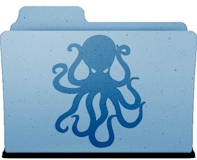 NEWS
NEWS
 NEWS
NEWS
 NEWS
NEWS
![]() Google launched Google Drive two weeks ago. For me, the service makes it simple to clear my hard drive of objects that I want access to later but without the messiness that comes with storing them locally on my already cluttered desktop. There are other use cases, of course, but for a guy like me, the new capability makes it far easier for me to keep images, logos and screen shots of any number of products and services I review in the course of my work.
Google launched Google Drive two weeks ago. For me, the service makes it simple to clear my hard drive of objects that I want access to later but without the messiness that comes with storing them locally on my already cluttered desktop. There are other use cases, of course, but for a guy like me, the new capability makes it far easier for me to keep images, logos and screen shots of any number of products and services I review in the course of my work.
VMware’s Project Octopus (Octopus) launched today. It is also a file syncing technology. It is more useful for the enterprise information worker in an organization that requires IT governance. It’s not necessarily for the freelancer or contract worker who needs fast, lightweight services to get a project done. I think twice about that statement, now. Isn’t that why business groups are pulling out their credit cards to use services like Google Docs? I think so.
Octopus and Google Drive show how companies like Google and VMware develop storage solutions according to the information architecture they have built. Both are mechanisms for storage and require an IT manager to launch and give permissions to use inside an enterprise environment that has adopted Google Apps and uses administrators to oversee it.
But what about Octopus?
Octopus provides the ability for IT to govern usage and set policies for data access and sharing within their organization or with outside contributors. Policies and provisioning get managed via VMware Horizon Application Manager, a centralized policy and entitlement engine that brokers user access to applications, virtual desktops and other data resources. Data can be accessed with any device. People may access, share, manage, search and update files with people inside or outside of the organization. It can also extend to any legacy, software as a service (SaaS) or proprietary application via open APIs.
Here’s more:
Access: Octopus enables workers to access and share their data through a Mac or Windows desktop. It can be accessed via the Web or mobile sync clients such as the iPad, iPhone, Android smartphone or Android Tablet. Blackberry nor Windows Phone 7 devices have sync capabilities at this point.
IT Administration: Full control for administrators – they set and manage policies to govern access and usage on a group, user or global basis to determine storage quota, external access and sharing, file retention and versioning. Every event is logged for auditing.
Runs on VMware vSphere Appliance: As a result it can be installed in a data center or through a service provider. It has the same storage elasticity, security and business continuity of VMware vSphere.
Availability: VMware Project Octopus beta will be available in 2012 for qualified customer trials.
Collaboration: Basic sharing, no co-editing, integration with Socialcast.
The services appear comparable. The major difference: the ease of use that comes when collaborations is part of the storage environment. That’s what makes Google Drive a strategic threat to the traditional storage leaders. The ability to store documents, co-edit and use a host of other features makes for a compelling combination. Octopus would be a potent beast if it had similar features.
Support our mission to keep content open and free by engaging with theCUBE community. Join theCUBE’s Alumni Trust Network, where technology leaders connect, share intelligence and create opportunities.
Founded by tech visionaries John Furrier and Dave Vellante, SiliconANGLE Media has built a dynamic ecosystem of industry-leading digital media brands that reach 15+ million elite tech professionals. Our new proprietary theCUBE AI Video Cloud is breaking ground in audience interaction, leveraging theCUBEai.com neural network to help technology companies make data-driven decisions and stay at the forefront of industry conversations.